| BIT DEPTH IN DIGITAL IMAGES |
 |
|
Bit depth is a type of color representation that dictates the color quality and precision of an image. This article explores the different bit depths available, and what this means for your images.
To learn about another aspect of image quality, see our article on Pixel Resolution and PPI.
|
SUMMARY
| WHAT IS BIT DEPTH? |
DIFFERENT BIT DEPTHS |
CHANGING BIT DEPTH |
IMAGE POSTERIZATION |
| Bit depth, or color depth, is how color precision is measured in a digital image. Different bit depths allow for a different number of unique colors to be viewed. |
The number of colors that can be created increases with the number of the bit depth. 1-bit color is monochrome - black and white only. 48-bit color can produce more than a billion different colors. |
Using an image editor, you can easily change the bit depth of the image. A photo taken with a low-bit depth camera will not be enhanced by doing this, however. |
Posterization occurs when the image cannot represent all the necessary colors. It looks like bands of color in areas of the image that should have smooth transitions. |
|
| WHAT IS BIT DEPTH?
|
 |
The term "bit depth", also known as "color depth", can mean one of two things (Wikipedia):
- the number of bits used to indicate the color of a single pixel; or
- the number of bits used for each color component of a single pixel.
Either way, bit depth is an indication of color precision, the number of unique colors available, in a digital image. All the colors available for that bit depth may not be used by all the images. The higher the bit depth, the smoother the tones and gradations will be between colors in the image. Bit depth is one of two types of color representation.
The other type of color representation is color gamut, which indicates the range of colors that can be portrayed.
|
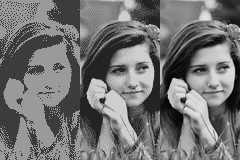
One image, three bit depths
|
| DIFFERENT BIT DEPTHS
|
 |
|
There are many different bit depths and each, in ascending order, offers smoother transitions between colors and shades. This makes sense: the more colors available to the image, the more gradually a color can fade or transition into another.
- 1-bit color is known as monochrome, and can produce only two colors: black, and white, or black and a single shade of gray.
- 2-bit color is known as CGA and can produce four colors: black, white, and two shades of gray.
- 4-bit color is sometimes called EGA and can produce 16 different colors/shades.
- 8-bit color is known as VGA and is capable of creating up to 256 distinct shades of gray or color. The bits are split between the three channels: 3 for R(ed), 3 for G(reen) and 2 for B(lue). Interestingly, blue has fewer bits because the human eye is less sensitive to tonal variations in blue than it is to those in red and green.
- 16-bit color is called XGA or high color, and offers as many as 65,536 different colors. Sometimes 16-bit is swapped for 15-bit.
- 32-bit color (which may sound familiar as one of two options for operating systems) offers a whopping 16,777,216 shades as well as transparency options. Since the human eye can identify about 10 million different colors, this color depth is more useful for offering wide variations, as opposed to actually showing images with nearly 17 million colors.
- 48-bit color is capable of recognizing more than a billion different colors. The color space sRGB can be used to represent 48-bit images, which are known as "deep color", and also include 30- and 36-bit.
Bit Depth Tutorial: the helpful interactive image at the end of this article shows you the visible difference between various bit depths.
|
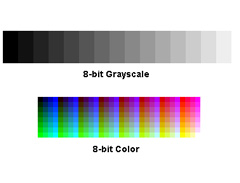
8-bit
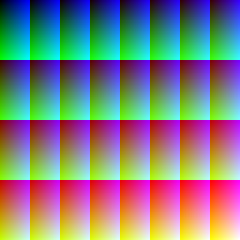
16-bit
|
| CHANGING THE BIT DEPT |
 |
|
The majority of photographs taken with a digital camera are rendered in 8-bit color. With these 256 colors, you can imagine why it is difficult to capture the true complexity of a sunset or a rainbow.
When you open a digital image in a photo editor like Photoshop, you can see the bit depth under Image > Mode. There will be a check mark beside either 8-, 16-, or 32-bit, as well as a checkmark beside RGB or CMYK (to learn more, see our article Understanding Color Models and Spaces). You can change the bit depth simply by selecting a different line.
That said, if your image opened as 8-bit, chances are it was taken by a camera capable of capturing 8-bit images. That means in the code of the photograph, only a maximum of 256 colors have been utilized. So, logically, changing the bit depth to accept millions of different colors is not going to do much good, and will increase your file size.
It is advisable to increase the bit depth, however, when you are planning to apply a lot of filters, colors, or other edits to your image. If you are adding colors from Photoshop, such as a gradient that merges from white into a bold red, you will want as many tints of red-white expressed between those two colors as possible.
It is important to keep in mind that whatever the bit depth, the image still will not present more colors than the paper or screen's color gamut is capable of.
8 Versus 16 Bit: this article has good examples of a single image at different bit depths.
|
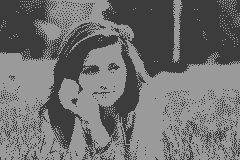
1-bit grayscale
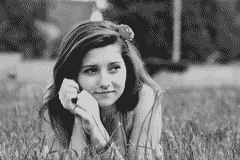
2-bit grayscale

8-bit grayscale
|
| WHAT IS IMAGE POSTERIZATION?
|
 |
|
Image posterization is the unfortunate result of lowering the bit-depth of an image, or taking an image with a device capable of a lower bit depth than is necessary.
Posterization is easy to see in the image's histogram (graphed depiction of the image) which will show a stretched out peak with a lot of vertical spikes. What the histogram is showing is the color requirements of the image being extended beyond its capabilities (its bit depth).
Instead of the smooth, natural-looking progression between colors or gradations (the blue sky as it nears the sun, for instance), the color appears banded, with distinct lines or chunks of color instead of a visually pleasing flow.
Essentially, the more posturized the image is, the fewer colors being used to depict that transition.
Though a lower bit depth doesn't automatically mean posterization will occur (the examples at the right are the same 8-bit image, with an adjustment filter applied), a higher bit depth will most always prevent it. This is why, as mentioned above, if you plan to add color gradients or other digitally applied transitions to your photographic image, you may choose to convert it to 16- or even 32-bit.
|
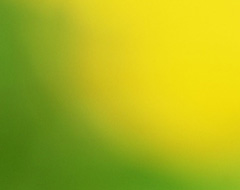
Unposturized color gradation
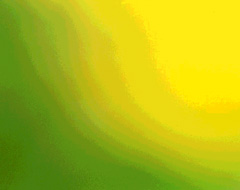
Posturized color gradation
|
| BINARY DIGIT BASICS
|
 |
|
To avoid confusion, we haven't looked at binary digits during our discussion on bit depth, but in fact, "bit" is short for binary digit.
Binary digits are the computer's language and will only ever be either 1 or 0. A binary number is made up of some combination of these digits; 1101, for instance.
When you begin creating numbers with more than one binary digit, you begin to have multiple combination options. This is where the number of colors for each bit depth come from. Consider that each binary number is a color.
1-bit offers only one digit, and so has two color possibilities: 1 and 0. 2-bit has four color possibilities: 01, 00, 10, and 11. 3-bit can create eight possibilities (8 different three digit numbers), and so on.
To learn more about binary digits and binary numbers, take a look at this simple and helpful article from Math is Fun.
|

Binary code made up of 1s and 0s
|
| BIT DEPTH AND PRINTING
|
 |
|
Bit depth is a factor for digital images - the printer itself does not have a bit depth. Certainly, if your image is 16-bit (and requires that depth), it will print more nicely than if you were to change it to 8-bit, but that change takes place in the digital file, not in the conversion to print.
Gamut is the aspect of color representation that comes into effect when printing. Different materials involved in the printing process have different color gamuts: the inks and the paper, most notably. If you know the image you are reproducing uses a wide range of colors, you will want to be certain you have selected a printer and a type of paper that can support and present those colors.
The Ultrachrome inks we use in our Epson printers have a very high color gamut (this is generally how gamuts are differentiated). However, certain fine art papers have lower gamuts than others.
|
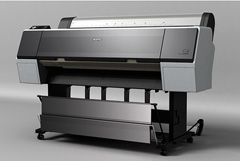
Our Epson 9890 inkjet printer
|
|
If you have questions about any of our services or products, don't hesitate to contact us. Our knowledgeable staff is always happy to assist with answers, advice, or suggestions.
|
|
© 2002-2025 - KeenART Media Ltd.
|
|
| |
|
